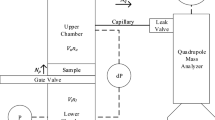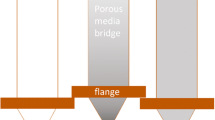Abstract
Developing a better understanding of xenon transport through porous systems is critical to predicting how this gas will enter the atmosphere after a below ground nuclear weapons test. Radioxenon monitoring is a vital part of the Comprehensive Nuclear-Test-Ban Treaty (CTBT) International Monitoring System. This work details the development of prompt gamma activation analysis for measuring the diffusion rates of xenon and argon gases through a porous medium. The University of Texas at Austin maintains a prompt gamma activation analysis facility with a peak neutron flux of ~1.5 × 107 cm−2 s−1 and a beam diameter of 1 cm. Due to the relatively large prompt gamma cross sections of many stable xenon isotopes at thermal and sub-thermal neutron energies, prompt gamma activation analysis is a suitable technique for in situ non-destructive analysis of natural xenon. A test chamber has been designed and constructed to utilize prompt gamma activation analysis to measure xenon and argon diffusion through geological materials (e.g., sand, soil, etc.). Initial experiments have been conducted to determine the detection limits for stable gas measurements. The results from these experiments will be utilized to benchmark parts of a xenon transport model that is being used to determine diffusion coefficients for xenon and argon.





Similar content being viewed by others
References
Wernsperger B, Schlosser C (2004) Noble gas monitoring within the international monitoring system of the comprehensive nuclear test-ban treaty. Radiat Phys Chem 71(3–4):5. doi:10.1016
Ringbom A, Elmgren K, Lindh K, Peterson J, Bowyer TW, Hayes JC, McIntyre JI, Panisko M, Williams R (2009) Measurements of radioxenon in ground level air in South Korea following the claimed nuclear test in North Korea on October 9, 2006. J Radioanal Nucl Chem 282(3):7. doi:10.1007/s10967-009-0271-8
Biegalski SR, Green TC, Alvarez E, Aghara S (2007) Background characterization of The University of Texas PGAA Facility. J Radioanal Nucl Chem 271(2):413–417. doi:10.1007/s10967-007-0224-z
Rèvay Z, Harrison RK, Alvarez E, Biegalski SR, Landsberger S (2007) Construction and characterization of the redesigned PGAA facility at The University of Texas at Austin. Nucl Instrum Methods Phys Res A 577(3):611–618
Biegalski SR, Green TC, Sayre GA, Charlton WC, Dorsey DJ, Landsberger S (2005) Flux weighted efficiency calibration of The University of Texas at Austin PGAA Facility. J Radioanal Nucl Chem 265(2):303–308. doi:10.1007/s10967-005-0825-3
Unlu K, Rios-Martinez C, Wehring BW (1994) The University of Texas cold neutron source. Nucl Instrum Methods Phys Res A 353(1–3):397–401
Takeda M, Nakajima H, Zhang M, Hiratsuka T (2008) Laboratory longitudinal diffusion tests: 1. Dimensionless formulations and validity of simplified solutions. J Contam Hydrol 97(3–4):117–134
Bird RB, Stewart WE, Lightfoot EN (2007) Transport phenomena, 2nd edn. Wiley, New York
Matyka M, Khalili A, Koza Z (2008) Tortuosity-porosity relation in porous media flow. Phys Rev E 78(2). doi:10.1103/PhysRevE.78.026306
Acknowledgments
The authors would like to thank the staff of the Nuclear Engineering Teaching Laboratory for their collaboration in this project and to the Department of Energy for funding this project under the contract No. DE-A-09NA28608.
Funding
This project was founded by the Department of Energy under the contract No. DE-A-09NA28608.
Disclaimer
This report was prepared as an account of work sponsored by an agency of the United States Government. Neither the United States Government, nor any agency thereof, nor any of their employees, makes any warranty, expressed or implied, or assumes any legal liability or responsibility for the accuracy, completeness, or usefulness of any information, apparatus, product, or process disclosed, or represents that its use would infringe privately owned rights. Reference herein to any specific commercial product, process, or service by name, trademark, manufacturer, or otherwise does not necessarily constitute or imply its endorsement, recommendation or favoring buy the United States Government or any agency thereof. The views and opinions of authors expressed herein do not necessarily state or reflect those of the United States Government or any agency thereof.
Author information
Authors and Affiliations
Corresponding authors
Rights and permissions
About this article
Cite this article
Rios Perez, C.A., Lowrey, J.D., Biegalski, S. et al. Xenon diffusion studies with prompt gamma activation analysis. J Radioanal Nucl Chem 291, 261–265 (2012). https://doi.org/10.1007/s10967-011-1328-z
Received:
Published:
Issue Date:
DOI: https://doi.org/10.1007/s10967-011-1328-z




